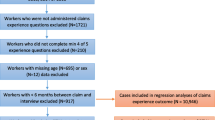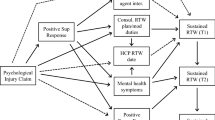Abstract
Purpose The employer/worker relationship can be an important catalyst for—or obstacle to—successful return to work (RTW). An understanding of factors associated with an injured worker’s relationship with their employer, and employer involvement in RTW planning, is warranted. Methods Analysis of n = 8808 cross-sectional survey responses from injured workers in nine Australian workers’ compensation (WC) jurisdictions. Workers completed a telephone survey between 6 and 24 months post-WC claim acceptance. Factors associated with the worker’s perception of employer support were examined using ordinal regression. Factors associated with employer provision of RTW plans were examined using logistic regression. Results Factors associated with employer support included being aged over 50 years, not having a mental health condition, better self-rated health and less time between injury and claim. Factors associated with having a RTW plan included being female, not having a mental health condition and working for a self-insurer. Factors associated with having a written RTW plan included being female and being under 50 years. There was wide variation in the provision of RTW plans between WC jurisdictions. Conclusions There are strong associations between worker, claim and injury-related factors and the injured worker’s experience of employer support. Identification of workers at risk of receiving inadequate support during the RTW process may enable interventions to improve support and RTW outcomes.

Similar content being viewed by others
References
Takala J, Hamalainen P, Saarela KL, Yun LY, Manickam K, Jin TW, et al. Global estimates of the burden of injury and illness at work in 2012. J Occup Environ Hyg. 2014;11(5):326–337.
Waddell G, Burton K. Is work good for your health and well-being? London: TSO; 2006.
Durand MJ, Corbiere M, Coutu MF, Reinharz D, Albert V. A review of best work-absence management and return-to-work practices for workers with musculoskeletal or common mental disorders. Work. 2014;48(4):579–589.
D’Amato A, Zijlstra F. Toward a climate for work resumption: the nonmedical determinants of return to work. J Occup Environ Med. 2010;52(1):67–80.
Franche RL, Baril R, Shaw W, Nicholas M, Loisel P. Workplace-based return-to-work interventions: optimizing the role of stakeholders in implementation and research. J Occup Rehabil. 2005;15(4):525–542.
Franche RL, Cullen K, Clarke J, Irvin E, Sinclair S, Frank J. Workplace-based return-to-work interventions: a systematic review of the quantitative literature. J Occup Rehabil. 2005;15(4):607–631.
Awang H, Tan LY, Mansor N, Tongkumchum P, Eso M. Factors related to successful return to work following multidisciplinary rehabilitation. J Rehabil Med. 2017;49(6):520.
Jetha A, LaMontagne AD, Lilley R, Hogg-Johnson S, Sim M, Smith P. Workplace social system and sustained return-to-work: a study of supervisor and co-worker supportiveness and injury reaction. J Occup Rehabil. 2018;28(3):486–494.
Butler RJ, Johnson WG, Cote P. It pays to be nice: employer-worker relationships and the management of back pain claims. J Occup Environ Med. 2007;49(2):214–225.
Negrini A, Corbiere M, Lecomte T, Coutu MF, Nieuwenhuijsen K, St-Arnaud L, et al. How can supervisors contribute to the return to work of employees who have experienced depression? J. Occup. Rehabil. 2018;28(2):279–288.
Bonneterre V, Perennou D, Trovatello V, Mignot N, Segal P, Balducci F, et al. Interest of workplace support for returning to work after a traumatic brain injury: a retrospective study. Ann Phys Rehabil Med. 2013;56(9–10):652–662.
State of Queensland. Guidelines for standard for rehabilitation. Brisbane: Office of Industrial Relations; 2016.
Safe Work Australia. Workers’ compensation legislation and psychological injury. Safe Work Australia: Canberra; 2014.
NSW Government. Draft guidelines for workplace return to work programs. Gosford: State Insurance Regulatory Authority; 2016.
Safe Work Australia. Comparison of workers’ compensation arrangements in Australia and New Zealand. Canberra: Safe Work Australia; 2017.
Lane TJ, Lilley R, Hogg-Johnson S, LaMontagne AD, Sim MR, Smith PM. A prospective cohort study of the impact of return-to-work coordinators in getting injured workers back on the job. J. Occup. Rehabil. 2018;28(2):298–306.
Australian Bureau of Statistics. Labour Force Australia. Canberra, Australia; 2018.
Lane T, Collie A, Hassani-Mahmooei B. What is the incidence of work-related conditions and their impact on time lost from work by state and territory, age, gender and injury type? Melbourne: Institute for Safety, Compensation and Recovery Research; 2014.
Collie A. Australian workers’ compensation systems. Understanding the Australian Healthcare System. 3rd ed. Melbourne: Elsevier Health; 2016.
Social Research Centre. Return to Work Survey: 2016 Summary Research Report (Australia and New Zealand). Melbourne: Safe Work Australia; 2016.
Social Research Centre. Return to Work Survey: 2013/14 Summary Research Report (Australia and New Zealand). Melbourne: Safe Work Australia; 2014.
Social Research Centre. Return to Work Survey: 2012/13 Summary Research Report (Australia and New Zealand). Melbourne: Safe Work Australia; 2013.
Australian Safety and Compensation Council. Type of occurrence classification system (Revision 1). 3rd ed. Canberra: Australian Government; 2008.
Gray SE, Collie A. The nature and burden of occupational injury among first responder occupations: a retrospective cohort study in Australian workers. Injury 2017;48(11):2470–2477.
StataCorp. Stata statistical software: release 15.1. College Station: StataCorp LLC; 2017.
Brijnath B, Mazza D, Singh N, Kosny A, Ruseckaite R, Collie A. Mental health claims management and return to work: qualitative insights from Melbourne, Australia. J Occup Rehabil. 2014;24(4):766–776.
Pomaki G, Franche RL, Khushrushahi N, Murray E, Lampinen T, Mah P. Best practices for return-to-work/stay-at-work interventions for workers with mental health conditions. Vancouver: Occupational Health and Safety Agency for Healthcare in BC; 2010.
Cooney R, Mwila NK. Improving return to work (RTW) coordinator training. Melbourne: Institute for Safety, Compensation and Recovery Research; 2013.
Smith JA, Braunack-Mayer A, Wittert G. What do we know about men’s help-seeking and health service use? Med J Aust. 2006;184(2):81–83.
Acknowledgements
This publication uses data supplied by Safe Work Australia and has been compiled in collaboration with state, territory and Commonwealth workers’ compensation regulators. The views expressed are the authors and are not necessarily the views of Safe Work Australia or the state, territory and Commonwealth workers’ compensation regulators. The authors would like to acknowledge the contribution of Ms Dianne Beck for assistance with data management, and Mr Shane Compton from the Social Research Centre for assistance with data provision and interpretation.
Funding
This project was funded by Safe Work Australia and WorkSafe Victoria through a grant to AC. Safe Work Australia provided the data for the study.
Author information
Authors and Affiliations
Corresponding author
Ethics declarations
Conflict of interest
The authors declare that they have no conflict of interest.
Ethical Approval
This study received ethics approval from the Monash University Human Research Ethics Committee (MUHREC) on 8 October 2014 (CF14/2995-2014001663).
Informed Consent
Informed consent was obtained from all individual participants included in the study.
Additional information
Publisher’s Note
Springer Nature remains neutral with regard to jurisdictional claims in published maps and institutional affiliations.
Electronic supplementary material
Below is the link to the electronic supplementary material.
Rights and permissions
About this article
Cite this article
Sheehan, L.R., Lane, T.J., Gray, S.E. et al. Factors Associated with Employer Support for Injured Workers During a Workers’ Compensation Claim. J Occup Rehabil 29, 718–727 (2019). https://doi.org/10.1007/s10926-019-09834-5
Published:
Issue Date:
DOI: https://doi.org/10.1007/s10926-019-09834-5




